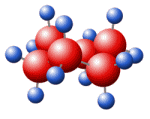|
|
|

|
Suppliers for
di-tert-Butyl dicarbonate (Di-BOC) (BOC-2O)
|
Properties | | CAS |
24424-99-5 | | Formula |
C10H18O5 | | EINECS |
246-240-1 |

|
|
6 Registered suppliers
Di-tert-butyl dicarbonate is a reagent widely used in organic synthesis. This carbonate ester reacts with amines to give N-tert-butoxycarbonyl or so-called Boc derivatives. These derivatives do not behave as amines, which allows certain subsequent transformations to occur that would have otherwise affected the amine functional group. The Boc can later be removed from the amine using acids. Thus, Boc serves as a protective group, for instance in solid phase peptide synthesis. It is unreactive to most bases and nucleophiles, allowing for an orthogonal Fluorenylmethyloxycarbonyl chloride (FMOC-Cl) protection.
| | Appearance & Physical State | White to off-white microcrystalline powder
| | Density | 0.95 g/mL at 25 °C(lit.)
| | Melting Point | 23 °C(lit.)
| | Boiling Point | 65-67 °C
| | Flash Point | 99 °F
| | Refractive Index | n20/D 1.409(lit.)
| | Storage Condition | 2-8°C |
Di-tert-butyl dicarbonate is a reagent widely used in organic synthesis. This carbonate ester reacts with amines to give N-tert-butoxycarbonyl or so-called Boc derivatives. These derivatives do not behave as amines, which allows certain subsequent transformations to occur that would have otherwise affected the amine functional group. The Boc can later be removed from the amine using acids. Thus, Boc serves as a protective group, for instance in solid phase peptide synthesis. It is unreactive to most bases and nucleophiles, allowing for an orthogonal Fluorenylmethyloxycarbonyl chloride (FMOC-Cl) protection.
| | Appearance & Physical State | White to off-white microcrystalline powder
| | Density | 0.95 g/mL at 25 °C(lit.)
| | Melting Point | 23 °C(lit.)
| | Boiling Point | 65-67 °C
| | Flash Point | 99 °F
| | Refractive Index | n20/D 1.409(lit.)
| | Storage Condition | 2-8°C |
Di-tert-butyl dicarbonate is a reagent widely used in organic synthesis. This carbonate ester reacts with amines to give N-tert-butoxycarbonyl or so-called Boc derivatives. These derivatives do not behave as amines, which allows certain subsequent transformations to occur that would have otherwise affected the amine functional group. The Boc can later be removed from the amine using acids. Thus, Boc serves as a protective group, for instance in solid phase peptide synthesis. It is unreactive to most bases and nucleophiles, allowing for an orthogonal Fluorenylmethyloxycarbonyl chloride (FMOC-Cl) protection.
| | Appearance & Physical State | White to off-white microcrystalline powder
| | Density | 0.95 g/mL at 25 °C(lit.)
| | Melting Point | 23 °C(lit.)
| | Boiling Point | 65-67 °C
| | Flash Point | 99 °F
| | Refractive Index | n20/D 1.409(lit.)
| | Storage Condition | 2-8°C |
Di-tert-butyl dicarbonate is a reagent widely used in organic synthesis. This carbonate ester reacts with amines to give N-tert-butoxycarbonyl or so-called Boc derivatives. These derivatives do not behave as amines, which allows certain subsequent transformations to occur that would have otherwise affected the amine functional group. The Boc can later be removed from the amine using acids. Thus, Boc serves as a protective group, for instance in solid phase peptide synthesis. It is unreactive to most bases and nucleophiles, allowing for an orthogonal Fluorenylmethyloxycarbonyl chloride (FMOC-Cl) protection.
| | Appearance & Physical State | White to off-white microcrystalline powder
| | Density | 0.95 g/mL at 25 °C(lit.)
| | Melting Point | 23 °C(lit.)
| | Boiling Point | 65-67 °C
| | Flash Point | 99 °F
| | Refractive Index | n20/D 1.409(lit.)
| | Storage Condition | 2-8°C |
Product Name: Di-tert-butyl dicarbonate
Synonyms: (BOC)2O;(BOC)2O FLUKA;BOC;BOC ANHYDRIDE;DI-T-BUTYL DICARBONATE;DI-T-BUTYL PYROCARBONATE;DI-TERT-BUTYL PYROCARBONATE;DI-TERT-BUTYL DICARBONATE
CAS: 24424-99-5
MF: C10H18O5
MW: 218.25
EINECS: 246-240-1
mp 23 °C(lit.)
bp 65-67 °C
density 0.95 g/mL at 25 °C(lit.)
refractive index n20/D 1.409(lit.)
Fp 99 °F
storage temp. 2-8°C
Sensitive Moisture Sensitive
BRN 1911173
Chemical Properties White to off-white microcrystalline powder
Usage Reagent commonly used in organic chemistry for the introduction of the BOC protecting group.
Product Name: Di-tert-butyl dicarbonate
Synonyms: (BOC)2O;(BOC)2O FLUKA;BOC;BOC ANHYDRIDE;DI-T-BUTYL DICARBONATE;DI-T-BUTYL PYROCARBONATE;DI-TERT-BUTYL PYROCARBONATE;DI-TERT-BUTYL DICARBONATE
CAS: 24424-99-5
MF: C10H18O5
MW: 218.25
EINECS: 246-240-1
mp 23 °C(lit.)
bp 65-67 °C
density 0.95 g/mL at 25 °C(lit.)
refractive index n20/D 1.409(lit.)
Fp 99 °F
storage temp. 2-8°C
Sensitive Moisture Sensitive
BRN 1911173
Chemical Properties White to off-white microcrystalline powder
Usage Reagent commonly used in organic chemistry for the introduction of the BOC protecting group.
|
|
|
Privileged suppliers
Last update 2024-04-26
|




 details
details
_Co_Ltd_1_575.jpg)
